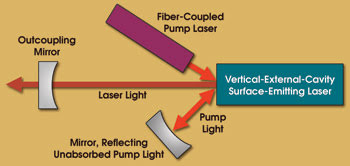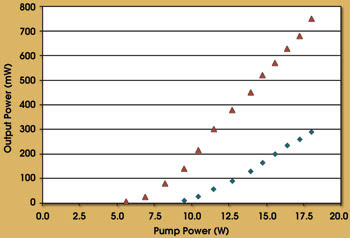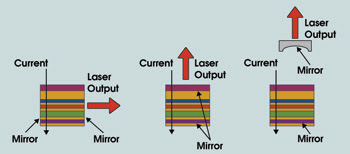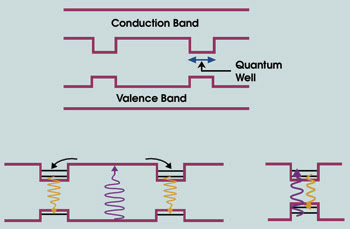By absorbing pump photons directly into the quantum wells, optically in-well-pumped vertical-external-cavity surface-emitting lasers offer shorter wavelengths and higher efficiencies than conventional barrier-pumped versions.
Marc Schmid, University of Strathclyde
Think fast: If you needed a wavelength-tunable laser with good beam quality in the near-infrared, what would you choose?
A Ti:sapphire or a dye laser probably immediately springs to mind, but each has its drawbacks. For example, Ti:sapphire lasers are expensive, and dye lasers are messy. Fortunately, there now is a third option: the optically pumped vertical-external-cavity surface-emitting laser (VECSEL).
Combining the advantages of a semiconductor laser with the convenience of a solid-state, VECSELs are an attractive source for both CW and pulsed outputs in the near-infrared. They achieve single-mode oscillation with a spectral tuning range of more than 25 nm at output powers of up to 8 W, and they produce good beam quality.
Optically pumped VECSELs can generate wavelengths shorter than 700 nm — better than a Ti:sapphire — but most of the work to date with the lasers has been in the 980-nm to 1.3-μm spectral region. Although they occasionally have been useful in the 830- to 850-nm range, they seldom find application at wavelengths shorter than 980 nm because the shorter wavelengths require expensive and often fragile pump lasers. Some commercial products have been available for a few years now, however, and more are likely to appear in the future.
Although optically pumping semiconductors is as old as the semiconductor laser itself, it is only in recent years that interest in this method has increased for a wider group of laser developers and users. At the University of Strathclyde, we are exploring ways to make optically pumped VECSELs at shorter wavelengths more attractive. Specifically, we are investigating a change from so-called barrier pumping to in-well pumping, in which the pump light is absorbed solely in the quantum wells (see sidebar “Optically Pumped VECSELs: A Primer” in the page opposite). This offers several advantages.
Pumping, mirror design
First, the pump wavelength required for a given output wavelength is longer for in-well than for barrier pumping, and pump lasers generally are cheaper and brighter at longer wavelengths. For example, InGaAs lasers with an output wavelength of between 950 nm and 1.3 μm can be pumped with powerful, relatively cheap 800- to 810-nm lasers that readily produce tens of watts of output.
On the other hand, conventional barrier-pumped GaAs lasers with an output wavelength of between 830 and 850 nm must be pumped with light shorter than 730 nm. Pump lasers at wavelengths shorter than 730 are expensive and typically capable of only several watts. In-well pumping a GaAs laser, however, enables the use of the powerful and cheap 800-nm pump lasers and still offers the 830- to 850-nm output.
Second, because of the smaller quantum defect in the in-well-pumped VECSEL, less heat is produced than in the barrier-pumped device. Thermal rollover is the main limiting factor for high-power operation of all optically pumped VECSELs. Thermal management will be an issue for in-well pumping, too, because much brighter sources are used, but the problem will occur at higher powers than for barrier-pumped lasers.
An important design consideration for an in-well-pumped VECSEL is the reflectivity of the Bragg mirror at the back of the cavity. The bandwidth must be great enough to reflect the pump and the laser light, or else most of the pump light, which is not absorbed in the gain area (likely more than 90 percent of the incoming pump power), will pass the Bragg mirror and heat the substrate. The resultant rise in temperature could be detrimental to laser operation — in the worst case, preventing the laser from reaching threshold.
Reflecting the pump light from the Bragg mirror also is the first step in addressing the biggest challenge for in-well-pumped lasers: ensuring that enough pump power is absorbed for efficient laser operation. Generally, only a small amount — less than 1 percent — of the pump power is absorbed in each quantum well. Most VECSELs today have six to 15 wells in the gain region. If the Bragg mirror reflects the pump light, the light passes through the wells twice. Even so, less than 20 percent will be absorbed.
Increasing absorption
We are studying three approaches to increasing the amount of pump power absorbed. The first comes from thin-disk lasers, in which the pump light is reflected again for multiple passes through the gain region. The second is an attempt to increase the absorption per well, and the third optimizes the VECSEL structure.
One GaAs laser we studied had 17 quantum wells with about 0.5 percent absorption for each pass of each well. This gave us approximately 15 percent absorption for a double pass of the pump light through the device. The cavity consisted of the Bragg mirror and an external 150-mm spherical output mirror with a transmission of 2 percent (Figure 1).

Figure 1. The optically in-well-pumped GaAs vertical-external-cavity surface-emitting laser features 17 quantum wells. The cavity comprises a Bragg mirror and an external curved output mirror that reflects the pump light to the structure for a second pass.
In the initial experiment, we pumped the VECSEL without the pump-reflecting mirror. An 803-nm diode laser coupled into a multimode fiber supplied the pump light. After emerging from the fiber, the pump light was focused into a 220-μm-diameter spot on the VECSEL. With 18 W of pump power incident on the VECSEL, the laser produced 290 mW of output at 850 nm.
We added the curved aluminum mirror, which reflected about 80 percent of the pump light for a second double-pass through the VECSEL. This increased the maximum output to 750 mW (Figure 2).

Figure 2. A plot of pump vs. output power reveals the benefit of the addition of the pump-reflecting mirror. Diamonds indicate the performance of the optically pumped device without the curved mirror; triangles indicate its performance with the mirror.
Adolf Giesen and his associates at Universität Stuttgart in Germany used a similar technique of multiple reflections through the gain medium in a thin-disk Nd:YAG laser. Their situation was similar to ours in that only a few percent of the pump light was absorbed in a single pass through the gain medium. With more complex mechanical arrangements, it is possible to reflect the pump light through the VECSEL as many as eight times, yielding a total of 16 passes. Thus, we expect that nearly 80 percent of the pump light would be absorbed in the gain structure and that the total absorbed pump power by this laser would be approximately 14 W.
If we were barrier-pumping this GaAs laser, we would need laser diodes emitting at below 730 nm. But such pump lasers lack sufficient brightness to pump it. So in-well pumping not only is cheaper than barrier pumping, but also gets more pump power into the laser.
In the second approach, we tried to improve the absorption in each quantum well. In general, increasing the width of the well increases its absorption, but it also changes the quantum character of the well, which affects the laser operation. Quantum mechanics dictates that this change in a well’s quantum character can be compensated by making the well deeper, which can be done by increasing the bandgap of the barrier region.
In a conventional barrier-pumped laser, increasing the bandgap of the barrier region would necessitate pump photons of shorter wavelength. With an in-well-pumped laser, however, the barrier-region bandgap doesn’t affect pumping. In-well pumping, therefore, gives us more freedom to change the shape of the well than does barrier pumping.
The third approach is to carefully design the semiconductor’s structure. Of course, increasing the number of quantum wells would increase the total absorption, but cost as well as semiconductor growth processes set a limit on the maximum number of wells. More interesting than just increasing the number of wells is to look at the weak microcavity built between the Bragg mirror and the finishing layer, including the gain area.
The refractive index difference between the finishing layer and the air is quite high, so the surface will act as a mirror. This microcavity, so far optimized only for the lasing wavelength, also can be used to enhance the pump light. The resonance wavelength of the microcavity becomes shorter, with a larger angle of incidence. Thus, by choosing the right angle and wavelength, we can enhance the pump power inside the microcavity.
Market impact
As these in-well-pumped semiconductor lasers mature and are introduced as commercial products, they are likely to change the face of the marketplace. The same high-power devices now limited to the 980-nm to 1.3-μm range will become available with outputs of several watts down to 830 nm, using the same robust and inexpensive pump sources. With pump sources only slightly less convenient, in-well-pumped VECSELs will have outputs as short as 700 nm. These inexpensive systems will have very good beam quality and output powers up to a watt.
Such lasers will be useful in research applications such as spectroscopy and atom cooling. Currently, the most common laser for these applications is the rather expensive Ti:sapphire, which, of course, has a wavelength tunability unsurpassed by any other laser. But most research groups seldom use this wide tuning range. For the most part, only a tunability over a small range around a very specific wavelength is required.
Being much less expensive, the optically pumped VECSEL will be an attractive alternative to the Ti:sapphire laser in many applications.
Meet the author
Marc Schmid is a lecturer in the department of physics at the University of Strathclyde in Glasgow, UK; e-mail: marc.schmid-at-strath.ac.uk.
Optically Pumped VECSELs: A Primer
Any semiconductor has a valence band and a conduction band, separated by a bandgap where electrons are forbidden.
In an electrically pumped semiconductor laser, a junction between dissimilar semiconductors is formed in which electrons and holes combine when a current passes through the device. An electron starts in the conduction band and a hole in the valence band, and a photon is created when they combine.
An optically pumped semiconductor laser needs no junction, no electrodes, no current and no doping. It is not a diode. A pump photon with energy larger than the semiconductor’s bandgap is absorbed, creates an electron in the conduction band and leaves a hole in the valence band. As in any optically pumped laser, a population inversion can be created between an upper level — in this case, the conduction band — and the lower level — the valence band.

Figure a. In an electrically pumped edge emitter, the light emerges perpendicular to the direction of the current. The mirrors are the surface of the semiconductor. Figure b. The output of an electrically pumped vertical-cavity surface-emitting laser emerges parallel to the pump current. The mirrors often are internal to the structure, rather than on the surface. Figure c. A vertical-external-cavity surface-emitting laser is a vertical-cavity surface-emitting laser with an external mirror. Note that this diagram illustrates an electrically pumped device.
Most semiconductor lasers are edge emitters (Figure a). A vertical-cavity surface-emitting laser (VCSEL), on the other hand, emits its beam from the surface (Figure b). A vertical-external-cavity surface-emitting laser (VECSEL) is a VCSEL with an external mirror (Figure c).
Although an optically pumped VECSEL need not have a junction between dissimilar semiconductors, it nonetheless comprises several distinct layers. First, a Bragg mirror is grown on the substrate, followed by the gain region and a protective window (Figure d). Quantum wells often are added to the gain region to decrease the threshold and increase the laser’s output power (Figure e).

Figure d. An optically pumped vertical-external-cavity surface-emitting laser has several layers but lacks the junctions between different semiconductors. Figure e. Quantum wells often are added to the gain section to enhance laser efficiency.
A quantum well is a thin layer — typically on the order of several nanometers — of a different semiconductor grown within the larger one. Because the bandgap of the well is smaller than that of the bulk, the well creates a depression in the conduction and valence bands of the semiconductor into which the charge carriers tend to “fall”; hence, its name (Figure f).

Figure f. The quantum wells are depressions in the semiconductor’s valence and conduction bands. Figure g. In a barrier-pumped laser, pump photons boost an electron from the valence band of the bulk into the conduction band. Figure h. In an in-well-pumped laser, the pump photon lifts an electron from a level in the quantum well’s valence band to the conduction band. The pump photon can be less energetic than in the barrier-pumped case. The calculation of the gain of a semiconductor is rather complicated and requires a deeper knowledge of the band structure of the material, which is beyond the scope of this primer. Nevertheless, it can be seen intuitively that, because the possible energy levels of the charge carriers in the quantum well are restricted, they are used in a more efficient way to produce population inversion than in the bulk material.
An optically pumped semiconductor laser is usually pumped in the barrier region; that is, the pump photons must be energetic enough to boost an electron from the valence band of the bulk material (outside the quantum well) into the conduction band, leaving behind a hole in the valence band (blue arrow, Figure g). The charge carriers then migrate to the quantum well and are stimulated to emit a photon of considerably lower energy than the pump photon (red arrows, Figure g).
To accomplish in-well pumping, it is necessary to pump with photons whose energy is insufficient to bridge the bandgap of the bulk material but large enough to boost an electron across the bandgap of a quantum well. In this case, the charge carriers are formed within the quantum well, and the stimulated photon’s energy is much closer to that of the pump photon (Figure h). The major difficulty with in-well pumping is the dramatic reduction in the absorption of pump light, because it can be absorbed only in the quantum wells.
The quantum defect — the energy difference between a pump photon and a laser photon — is much smaller for an in-well pumped laser, so there is much less waste heat to be dissipated. That’s important, because thermal management is the main barrier to high-power performance of these devices. Moreover, the smaller quantum defect allows shorter-wavelength lasers to be pumped with inexpensive, robust pump lasers. Powerful 800- to 810-nm pump lasers, developed for pumping Nd:YAG lasers, can barrier-pump a semiconductor laser whose output is in the 980-nm to 1.3-μm range. With in-well pumping, the laser’s output can be as short as 830 nm.
It should be noted that the positive effect of the quantum-well structure on the population inversion (and therefore on the laser threshold) is an advantage of quantum wells in both edge emitters and vertical-cavity lasers. In the latter, however, quantum wells offer a second advantage: They can be spaced so that they lie at the antinodes of the standing wave of the laser resonator. In that case, the interaction between the optical fields and the population inversion is further enhanced, and laser efficiency is increased.